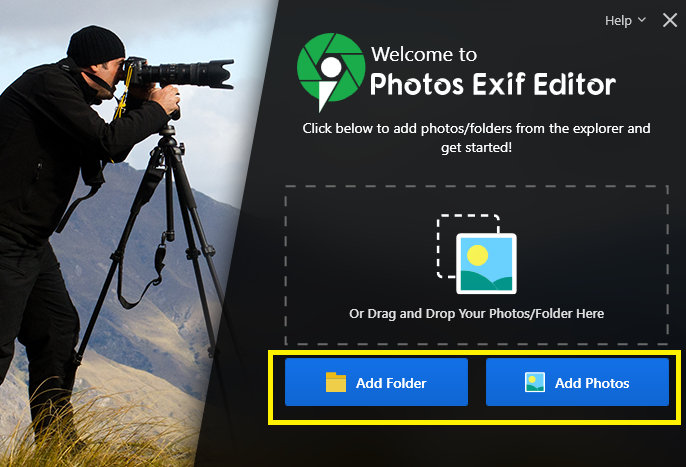

- BATCH PHOTO EXIF EDITOR FOR JPEG AND RAW WINDOWS HOW TO
- BATCH PHOTO EXIF EDITOR FOR JPEG AND RAW WINDOWS FULL
- BATCH PHOTO EXIF EDITOR FOR JPEG AND RAW WINDOWS SOFTWARE
- BATCH PHOTO EXIF EDITOR FOR JPEG AND RAW WINDOWS ISO
- BATCH PHOTO EXIF EDITOR FOR JPEG AND RAW WINDOWS DOWNLOAD
It requires: T, Ctrl-A, Alt-F, J, Enter, (Alt-F), Enter To do this for a batch of files SOUNDS complex to learn.


Seeing why the 1st few times takes longer. To convert a single file's date/time to EXIF values requires Source: Free from This is MUCH easier and quicker in practice after just a few uses than the instructions below make it appear.
BATCH PHOTO EXIF EDITOR FOR JPEG AND RAW WINDOWS HOW TO
Irfanview version can be invoked from a command line or internally in a batch or on a file by file basis.Įxample below for Irfanview shows how to copy in either direction:Īllows GUI or command line changes of batch or per file date/time transfer from EXIF to file spec or vice versa (with no other file changes if so desired). Jhead is command line driven or can be called by other processes. Irfanview and jhead will both do what you want. Exiv2īeware that with lowercase -t (or without any -T) Exiv2 will also rename the file to a new name based on the timestamp, which may be very confusing. (Remove the -r if you don't want recursion, and if you do that, you can also give a list of files or a wildcard instead of directoryname.) And be careful with those quotes - if you're running this on Windows, you want " instead of '. Just for completeness, though, I did look at the documentation, and with ExifTool, do this: exiftool -r '-DateTimeOriginal>FileModifyDate' directoryname I can never remember offhand the right options to do anything with those and have to look at the documentation every time, but jhead -ft is easy to remember with the mnemonic "fix time". Other utilities like ExifTool or Exiv2 are much more capable, but at the price of complexity. found, without executing any other command (like jhead): find. You can also use find to just show all the files that would be. In order to perform recursion into subdirectories, you could to combine it with the find command available on Linux/Unix/Mac (or Cygwin for Windows): find. jhead with find, for going through subdirectories

Sets a bunch of files so that the file timestamp matches EXIF. Of these, for this very simple task, jhead is my suggestion.
BATCH PHOTO EXIF EDITOR FOR JPEG AND RAW WINDOWS SOFTWARE
GeoSetter can change a digital image GPS coordinates, the date it was taken, IPTC data and much more.This is the inverse of Is there any software which will set the EXIF Dates based on the file's modification date?, and I'm sure all of the programs listed there will apply. GeoSetter: Image utility that can read and most digital cameras RAW images, it shows existing geo coordinates and tracks on embedded Google Maps, Internet access needed.
BATCH PHOTO EXIF EDITOR FOR JPEG AND RAW WINDOWS DOWNLOAD
InfanView: This small free photo viewer show Exif/IPTC/comments information from JPG files, the Exif data can not be edited but the IPTC and comments can, IrfanView plugins are available for download extending the photo viewer capabilities.
BATCH PHOTO EXIF EDITOR FOR JPEG AND RAW WINDOWS FULL
IPTC comments are also supported and displayed, you can view all of that in full screen if you wish.
BATCH PHOTO EXIF EDITOR FOR JPEG AND RAW WINDOWS ISO
You can access image file Exif data in Windows locating the image file, right clicking on it and selecting “ Properties” from the menu that appears, the “ Advanced” tab of “ Properties” shows further details, Windows does not show all of the embedded metadata on a file, a proper Exif data viewer will do.ĭigital photographs metadata, aka Exif data, can be read by software programs, if you open, edit and then save an image file with software that does not support metadata you risk losing it altogether.įree Photo Viewer: Lightweight Exif data viewer that shows aperture, shutter speed, ISO value, camera model, focal length, time and date, flash settings, etc. In images, Exif data typically includes the date and time the picture was taken, type of camera and model, software used to edit the image, picture resolution, and if the device used to take the photograph has GPS capabilities, like the iPhone, it will also include the geographic coordinates of where the photograph was taken. When you take a photograph with a digital camera or edit it with a graphical editor, there will be data embedded in the image file, most smartphones also embed metadata in the pictures they take, this semi hidden data it is called Exif (EXchangeable Image File Format) data, Exif data is not exclusive of image files, it can also be found in audio and video files.


 0 kommentar(er)
0 kommentar(er)
